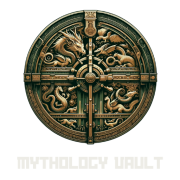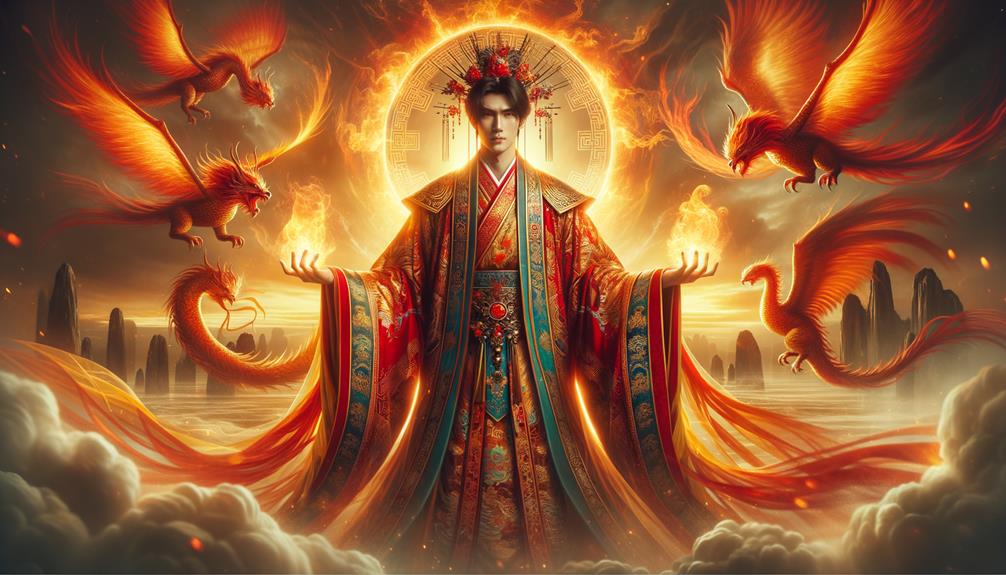Di Jun, the Flame Emperor, blazed brilliantly from the cosmic intersection of day and night. Through unions with Xihe and Changxi, he fathered ten Suns and twelve Moons, dancing precariously between creation and destruction. When the ten Suns threatened Earth's serenity, the heroic archer Hou Yi restored balance, armed with mystical arrows. Di Jun's legend weaves harmony and chaos, shaping Chinese cultural values through timeless tales that still resonate today.
Origins of Di Jun
Di Jun's legend began at the cosmic intersection of day and night. Born from the sun and moon's celestial dance, he inherited their fiery brilliance and serene glow, forging him into a being of immense power and wisdom. His name combined the characters for emperor and handsome, reflecting his regal stature and divine beauty.
In his early days, Di Jun's connection to the sun manifested profoundly as the Flame Emperor. He fathered ten Suns, magnificent blazing orbs that threatened to scorch the Earth to oblivion. Balancing this overwhelming power became Di Jun's quest, shaping myths and legends.
His name resonated with nobility, symbolizing his divine origins and cosmic lineage. Guided by celestial constellations, Di Jun illuminated destiny's path, carrying the heavens' weight.
The ancient myths whispered of Di Jun's emergence from the dawn of time, intertwining his lineage with the sun and moon's essence. This duality made him a figure of immense wisdom and power.
Di Jun's Family
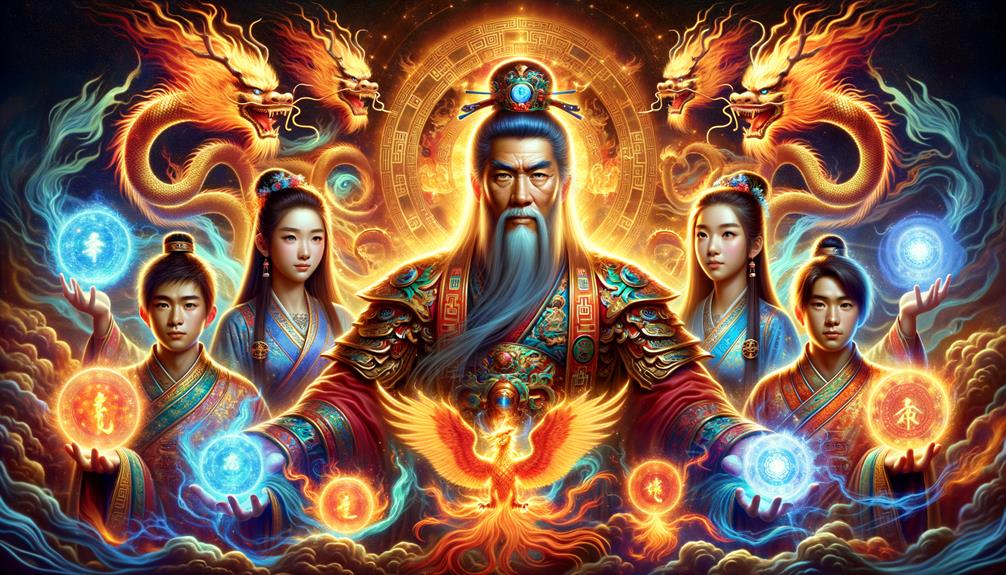
Di Jun's family defies conventional understanding, intertwining celestial beings and cosmic forces. As the Emperor Jun, his relationships with the sun goddess Xihe and the moon goddess Changxi transcend ordinary bonds, forming the bedrock of the celestial realm's stability.
Di Jun, the Flame Emperor, boasts an extraordinary lineage comprising ten Suns and twelve Moons, signifying his dominion over the heavens. His family tree is a cosmic hierarchy in itself:
- Xihe, the Sun Goddess: She birthed Di Jun's ten radiant Suns, each representing a day in the traditional Chinese week.
- Changxi, the Moon Goddess: She bestowed upon him twelve luminous Moons, symbolizing the months and time's cyclical nature.
- Ten Suns: Their combined heat once threatened Earth until the heroic archer Hou Yi, guided by Di Jun, restored balance.
- Twelve Moons: They govern the night skies, maintaining the delicate equilibrium between darkness and light.
In Chinese mythology, Di Jun's family embodies the eternal interplay between celestial forces and mortal existence, illustrating the intricate balance the Emperor tirelessly upholds.
The Ten Suns
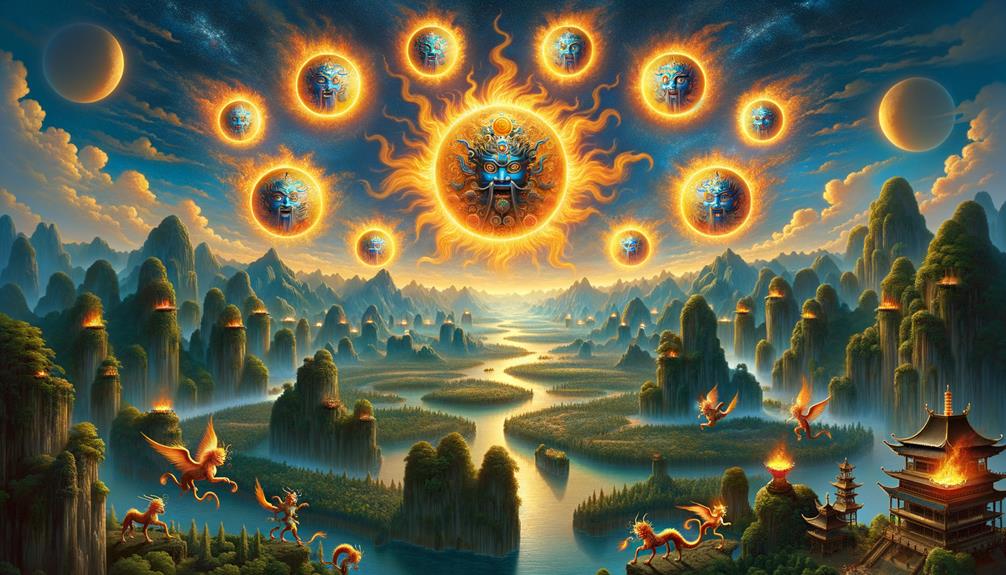
The ancient Chinese myth of the Ten Suns underscores the precarious balance between creative and destructive forces in nature. Di Jun, the celestial deity, had fathered ten offspring who took turns lighting up the skies. However, when all ten appeared simultaneously, their combined heat threatened to scorch the Earth into a barren realm. Rivers evaporated, crops withered, and life hung by a thread.
This narrative symbolizes nature's dual capacity for sustenance and devastation. Di Jun realized intervention was crucial to restoring equilibrium. He armed the archer Hou Yi with divine arrows, acknowledging that reining in the excessive force was necessary.
The Ten Suns story reminds us that unchecked power, even from life-giving sources, can be cataclysmic. It teaches the vital importance of moderation and illustrates how excessive behavior can upend the natural order. While Hou Yi faced a heroic challenge, that's a tale for another recounting.
Hou Yi's Heroic Deeds
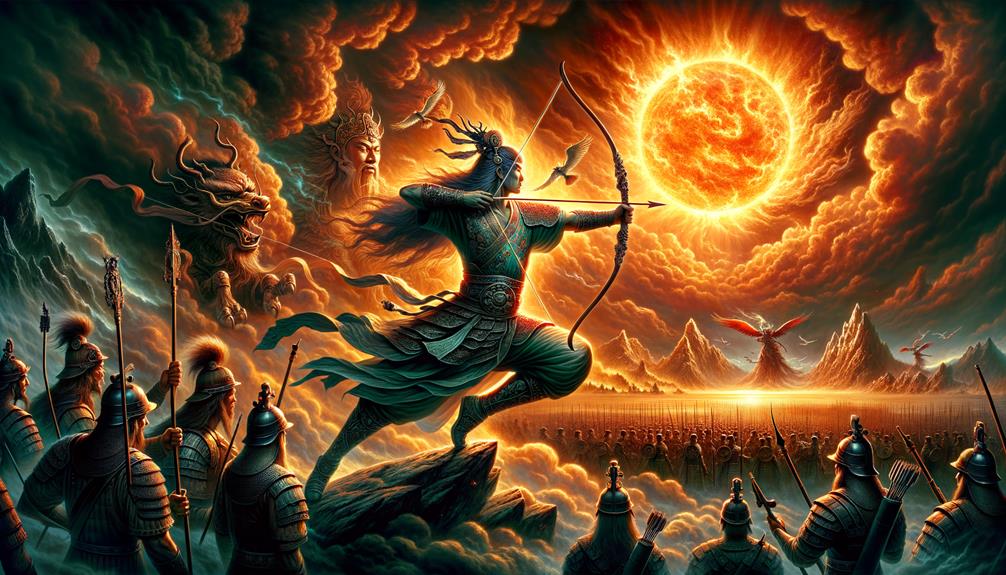
Armed with celestial arrows, Hou Yi ventured onto the scorched landscape to confront the blazing suns wreaking havoc. The ten Suns, Di Jun's children, had scorched the earth, sparking droughts, fires, and immense suffering. Recognizing the imminent disaster, Di Jun equipped Hou Yi with specialized arrows harnessing cosmic power.
Hou Yi's journey was the stuff of legends. As he aimed his bow at the first Sun, the atmosphere crackled with tension. One by one, his arrows struck true, and the Suns plummeted from the sky. The earth breathed a collective sigh of relief as temperatures cooled, and life gradually returned to normalcy.
Key moments in Hou Yi's heroic feats:
- Divine Armament: Di Jun supplied Hou Yi with mystical arrows to face the Suns.
- Pinpoint Precision: Hou Yi's unparalleled archery skills downed nine Suns.
- Equilibrium Restored: With nine Suns vanquished, the calamity ceased.
- Mythic Legacy: Hou Yi's bravery solidified his place as a revered Chinese mythological hero.
Hou Yi's actions personify the archetypal hero's journey, where courage and divine intervention restore cosmic harmony.
Cultural Impact
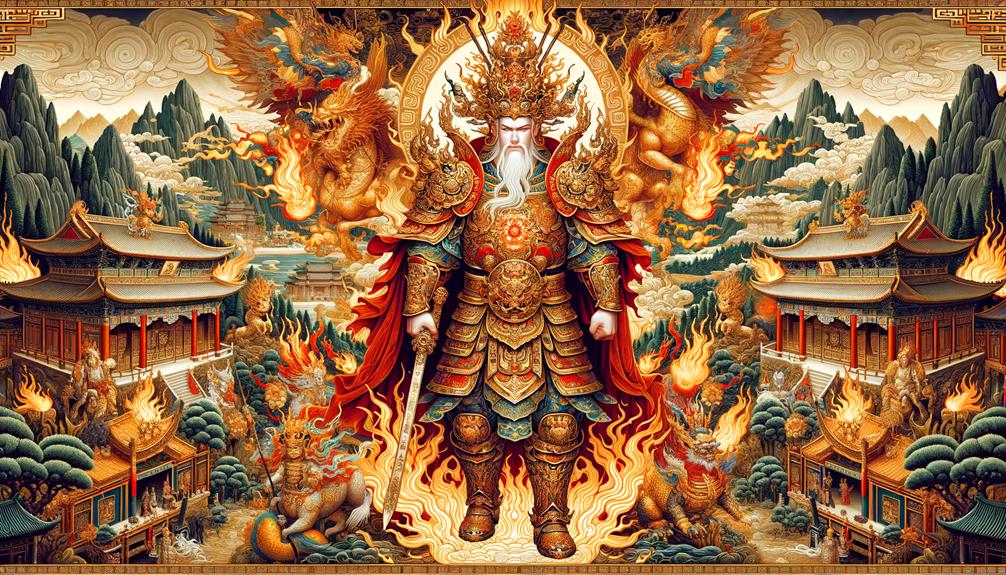
For ages, the tale of Di Jun and Hou Yi has captured the Chinese imagination, weaving cosmic struggle and divine intervention into society's fabric. This myth, where the celestial emperor Di Jun fathers ten Suns and archer Hou Yi restores balance by shooting down nine, encapsulates an epic journey of conflict and resolution. The characters and their otherworldly traits symbolize the eternal clash between chaos and order, a theme that continues to resonate.
Di Jun's marriage to sun goddess Xihe and moon goddess Changxi enriches the myth, depicting nature's harmonious balance. These relationships reflect the yin and yang worldview, where opposing forces unite to maintain cosmic equilibrium.
Di Jun's mythical influence transcends storytelling, shaping literature, art, and rituals. His portrayal as a celestial ruler embodies power, inspiring countless works celebrating his legacy. Traditional beliefs often invoke his name, underscoring his enduring significance. Through diverse mediums, Di Jun's myth continues molding and mirroring Chinese society's values and beliefs.
Modern Interpretations
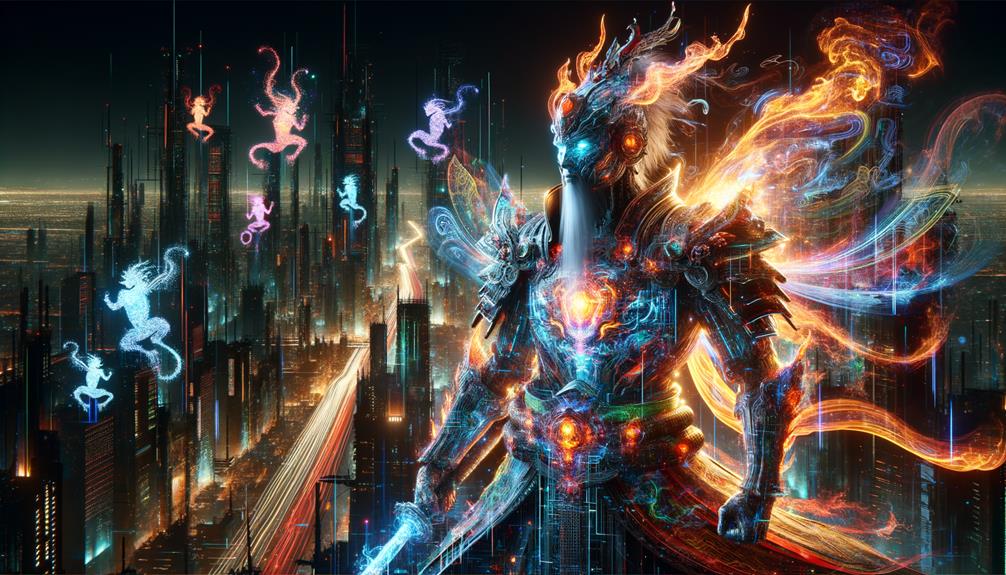
Contemporary depictions of Di Jun cast the mythological figure as a timeless embodiment of agrarian prosperity and divine authority. As a celebrated Chinese deity, Di Jun's influence transcends ancient texts and folklore.
Today's storytellers breathe new life into Di Jun's legend through various mediums:
- Literature weaves his celestial powers into epic narratives, portraying him as a guardian of balance and abundance.
- Artists render Di Jun surrounded by lush landscapes and radiant sun motifs, symbolizing his role in nurturing life.
- Pop culture features Di Jun in films, shows, and games, often as a wise, powerful mentor guiding heroes.
- Cultural events blend traditional rituals with modern performances celebrating Di Jun's enduring legacy.
These reimaginings highlight Di Jun's significance in Chinese heritage, emphasizing his divine origins and abilities. Through continual exploration and creative interpretation, Di Jun's mythological essence resonates, bridging ancient and contemporary realms.
Frequently Asked Questions
Who Is the Flame Emperor in Chinese Mythology?
Yandi, a legendary Chinese ruler, transformed early civilization through his mastery of fire and invention of tools. As a warrior-king, he's honored for propelling ancient China forward through pivotal advancements.
His mythology casts him as a guiding luminary, introducing groundbreaking innovations that shaped society. Yandi's mythical feats solidified his status as a civilization-changing hero who left an indelible mark on Chinese history and culture.
What Is the Myth of the Chinese Emperor?
As an emperor closely tied to the heavens and agricultural cycles, legend speaks of my ten suns scorching the Earth. The archer Hou Yi stepped in, shooting down nine suns to restore balance – an act reinforcing my profound celestial and agrarian connections.
Why Was Huangdi Known as the Yellow Emperor?
In Chinese legends, Huangdi, known as the Yellow Emperor, represented the Earth and civilization's beginnings. His mythical reign brought innovations in medicine, governance, and agriculture – accomplishments that earned him reverence.
What Is the Myth of the Candle Dragon?
The Candle Dragon myth captures fire's transformative essence. This celestial guardian, with a living candle-like fiery body, represents eternal radiance and protection, guiding realms with brilliant flames. Imagine a mythical creature whose very presence illuminates and shields from darkness, using its mystical blaze to bring warmth and security. The metaphor reminds us that even modest flames can dispel shadows and spark hope. Like this symbolic dragon, we can be beacons radiating strength and resilience in turbulent times. The tale encourages embracing our inner light to positively impact our surroundings.
